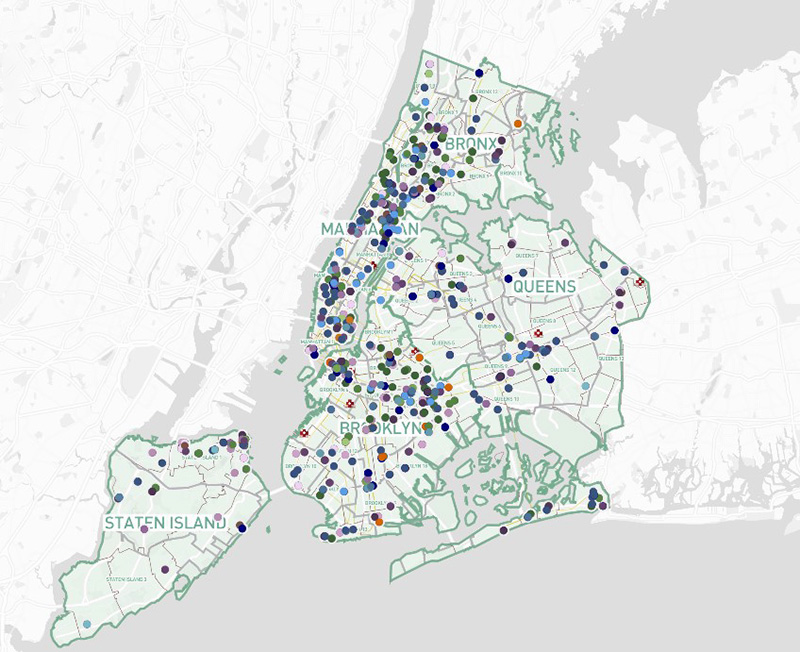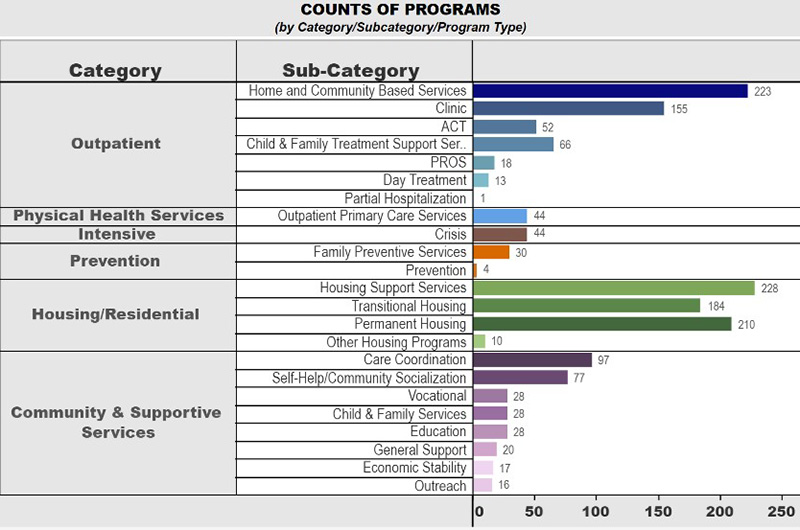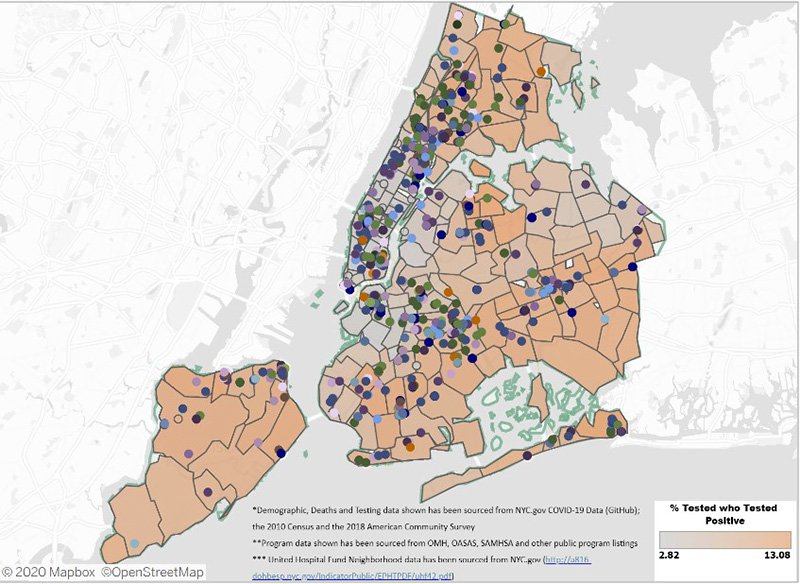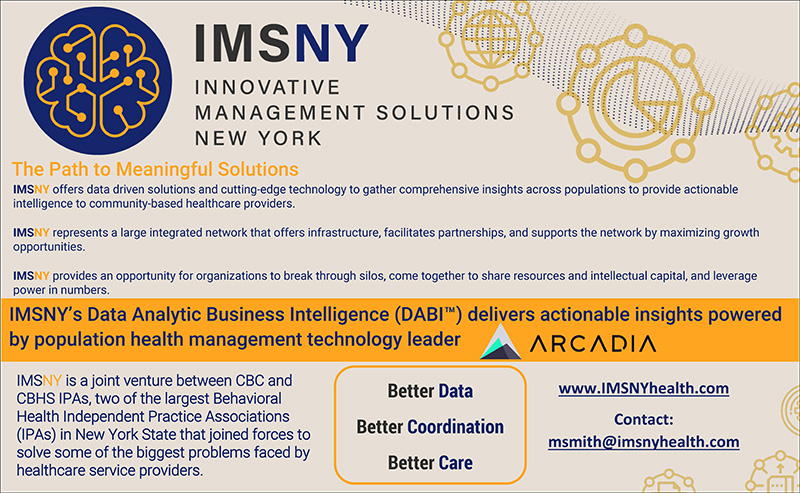The Centers for Disease Control (CDC) describes Social Determinants of Health (SDoH) as “conditions in the places where people live, learn, work, and play that affect a wide range of health and quality-of life-risks and outcomes.”1 The impacts of these social determinants of health are well documented,2 requiring targeted and responsive programs like food pantries, vocational services, and peer-led support networks. Despite a growing awareness of the connection between these SDoH need(s) and health outcomes, our current healthcare system still lacks an effective coordination strategy between healthcare providers and community based SDoH services. A primary impediment relates to a lack of knowledge of myriad services available in a community and incomplete service/provider resource directories/maps which impacts the capacity for care coordinators and service providers to easily locate and match individuals to the right service in real time.
Innovative Management Solutions of New York (IMSNY), a joint venture developed by two of the largest Behavioral Health Independent Practice Associations (IPA) in New York (CBC and CBHS), recognized early on this disconnect and committed to overcoming the harmful impact that healthcare disparities, manifesting in pronounced gaps in care, have on people with behavioral health (BH) needs. Community-based health and human service agencies within the IPA’s networks are painfully aware that, for example, lack of stable housing undermines attempts to manage a person’s chronic health condition and that underdeveloped transportation infrastructure in an impoverished neighborhood reduces access to preventive care. IMSNY believes that developing a network-wide solution—offering the right tools and resources— brings together otherwise disconnected community programs to collaborate in an ecosystem that is communicative and leverages data to inform care coordination decisions.
IMSNY and SDoH: Our Solution
Meaningfully connecting a large BH provider network requires substantial front-end effort, followed by continued maintenance. While the initial agreement amongst providers to participate is a necessary first step, success hinges on a sound strategic plan that leverages available technology and “project manages” the collection and integration of agency specific program and service information.
Through focus groups, targeted projects with network agencies, and data analysis, IMSNY identified three crucial steps for addressing SDoH in a network context:
- Map the local system of community-based supports that exist and create tools for visualizing patient-populations needs in real time or “close to real time”
- Build a data warehouse that pools together disparate datasets allowing a complete view of every patient’s treatment
- Close gaps in care through a closed/curated network with the ability to make closed-loop referrals
Step 1: Map the local system of community-based supports that exist and create tools for visualizing patient-populations needs in real time or “close to real time”
A Geomap is “a map of a country, continent, or region map, with colors and values assigned to specific regions. Values are displayed as a color scale, and you can specify optional hover text for regions.”3 IMSNY created an BH Network Geomap, aggregating and displaying the services of the IPA’s BH provider agencies, inclusive of SDoH programs. See Figure #1.

Figure 1: CBC BH Network Geomap
This BH Network Geomap was developed side-by-side with a unified behavioral health taxonomy that leverages existing classification for the numerous service types both medical and non-medical in the behavioral health sector, as published by regulatory bodies and payers. See Figure #2.

Figure 2: CBC BH Network Taxonomy
The BH Network Geomap allows providers to easily visualize the network of behavioral health and social supports that can be accessed locally, along with a visualization of the broad category to which the service program belongs. Agencies are able to use this tool to create strategic partnerships with other agencies within their network and fill care-gaps, including non-medical and SDoH care-gaps. Additionally, the BH Network Geomap can be layered onto different datasets, allowing provider agencies to visualize the needs of patient populations in a timely manner so that targeted care can be delivered at the right time, in the right place(s). For example, the BH Network Geomap was used to layer the CBC IPA Network over COVID hot spotting, providing the IPA with actionable intelligence around the health needs in communities with high rates of COVID infection, COVID deaths, and other related datapoints. This geo-mapping with layered data and hotspots was crucial in the recent successful award of a SAMHSA COVID Emergency Grant, in partnership with New York Stater Office of Mental Health (OMH) and Office of Addiction and Support Services (OASAS) and CBHS IPA.
With this information readily available, network providers can leverage data to develop strategies for community outreach, including evidence-based care strategies and other hot-spotting initiatives.

Figure 3: COVID-19 Hot-Spotting over CBC Network Map
Step 2: Build a data warehouse that pools together disparate datasets allowing a complete view of every patient’s treatment
IMSNY has partnered with Arcadia4 to implement Data Analytic Business Intelligence (DABI), a centralized platform that pools together data from a variety of external sources. These sources include regional Health Information Exchanges (HIE), PSYCKES, network agency electronic health records (EHRs) and billing files. The DABI platform is designed to facilitate population health data analysis, inform quality oversight and performance, and expand each participating network’s negotiating power through predictive modeling and risk stratification. Additionally, it can track costs, utilization, and return on investment. Because it is especially critical to the targeted delivery of SDoH services, DABI includes built-in customized SDoH based quality metrics as a mechanism for tracking successes related to non-medical and SDoH care-gaps.
DABI can provide agencies with a complete view of the individuals they serve, showing them not only the services received at their own agency, but also at any other agency within their IPA. For example, access to Admission-Discharge-Transfer (ADT) data from local hospitals and emergency care providers is critical to patient care, and assists agencies in making cost-saving, targeted decisions regarding the next step in an individual’s care. In tandem with the built-in custom SDoH measures in DABI, having information in one centralized place allows for an aggressive SDoH strategy designed to help the entire network succeed in the increasingly outcome-based healthcare environment.
Step 3: Close gaps in care through a closed/curated network with the ability to make closed-loop referrals
Closed networks and closed loop referrals, though closely related, are not exactly the same thing. A closed network is a group of providers who have come together to form a coordinated service network, in which their mutual agreements and partnership represents a shared understanding and approach to meeting community needs. An IPA can be a closed network, as member agencies have come together around clinical targets and network goals. The stumbling block is often not the vision, but in the execution of that vision, (i.e., technology). While the BH Network Geomap and DABI assist behavioral health providers with identifying gaps in care and opportunities for care coordination, a crucial final component in IMSNY’s system is a platform where the actual work of referring and coordinating with partner agencies to close the identified care-gaps can be done. Thus, IMSNY is now developing a platform called ConnexRXTM so IPA member agencies can share “closed-loop” referrals within the network, more efficiently identify the right service for their client and generate the feedback needed to ensure the client has received the referred service. ConnexRXTM is a flexible system which can be configured for specific projects to track metrics in real time ensuring outcomes are being met and adjustments can be made quickly whenever necessary. CBHS has already processed close to 2,000 referrals thorough ConnexRXTM and member agencies have used the system for a variety of initiatives related to Home and Community Based Services (HCBS), transitions of care, and as part of a Level 2 value-based contract. Future enhancements of ConnexRXTM include a Shared Care Form that will allow all the providers involved in a client’s care to coordinate services in one place and leveraging both the visual capacities of the geo-mapping effort, and the rich data from DABI to assist providers in understanding where any gaps in care exist so they can be closed.
Conclusion
The healthcare system as a whole is rightly turning their focus to SDoH to identify the non-medical realities that impact individuals’ ability to manage their behavioral health needs safely and productively. Capacity to respond to the ever-growing body of evidence supporting greater investment in SDoH is confronted by lack of network cohesion and challenges around effective use of data to make optimal referrals. IMSNY is mapping out the provider network, collecting individual and aggregate level information, tracking outcomes in real time, and offering a closed-loop referral solution for network providers. By doing so IMSNY gives network providers the tools they need to expand their service arrays and offer all the supports needed by complex and vulnerable populations to live healthier and happier lives.
Jorge R. Petit, MD (Co-CEO), Mathew Smith (COO), and Khushi Shah (Data Solutions Manager) are at IMSNY, focused on supporting behavioral health networks. To connect, reach out to msmith@imsnyhealth.com.
Footnotes
- Centers for Disease Control and Prevention, Social Determinants of Health: Know What Affects Health
- Artiga, Samantha & Hinton, Elizabeth, KFF 2018, Beyond Health Care: The Role of Social Determinants in Promoting health and Health Equity
- Google Charts: Visualization: Geomap – Charts – Google Developers
- Arcadia is a healthcare data and software company dedicated to healthcare organizations achieving financial success in value-based care. Arcadia Analytics, their purpose-built population health platform, delivers enterprise-level transformational healthcare outcomes.





